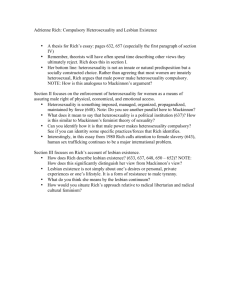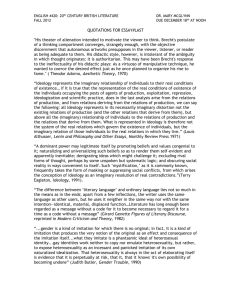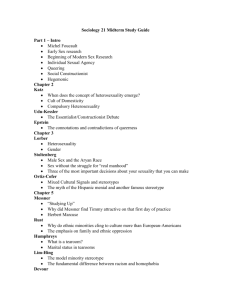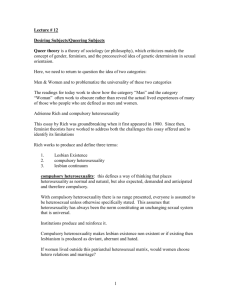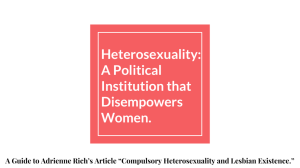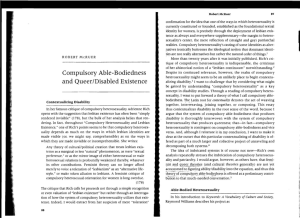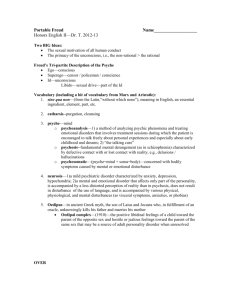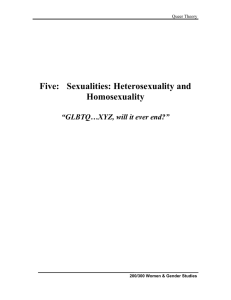White Weddings
advertisement
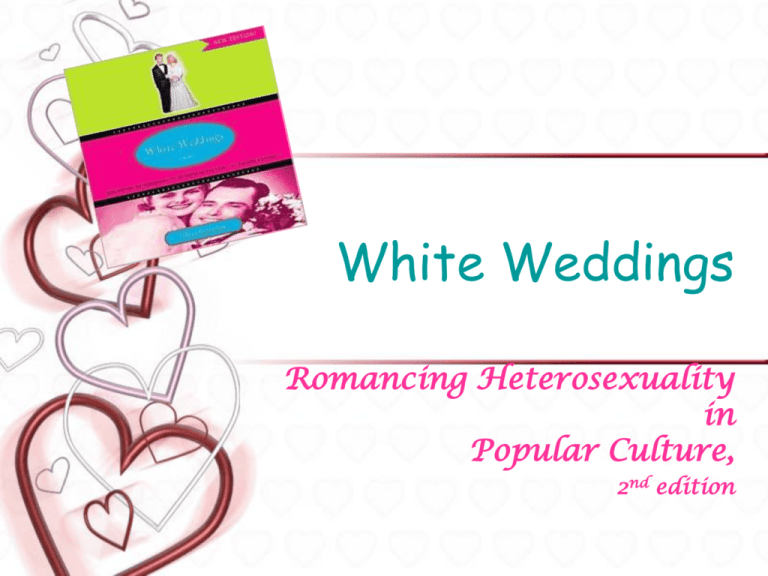
White Weddings Romancing Heterosexuality in Popular Culture, 2nd edition Focus of this book • Objective: to examine the institutionalization of heterosexuality through the operation of the traditional white wedding. • To explicate the underlying social, economic, and cultural patterns of current wedding trends to determine how heterosexuality is institutionalized. • Definition: A white wedding is a spectacle featuring a bride in a formal white wedding gown, combined with some combination of attendants, religious ceremony, and wedding reception. • Integrally linked to marriage, weddings provide an important cultural site for understanding the organization of heterosexuality. Lifting the veil • Until recently weddings have been overlooked by researchers. • Why do weddings receive so much attention from the media? • How could they be so present in popular culture yet so absent from academic scrutiny? • Do we take them so much for granted that we don’t think that they merit study? • What exactly is the significance of the white wedding? Lifting the veil • Wedding culture and the wedding industry provide clues to the larger social interests they serve. • They provide a rich source of data about how we give meaning to heterosexuality and marriage. • White weddings are a concentrated site for the operation and reproduction of organized heterosexuality. • More so than other prominent heterosexual practices or rituals, weddings are culturally pervasive, symbolically prolific, are rarely questioned or examined. • They are so taken for granted that they seem naturally occurring and function to institutionalize a host of heterosexual behaviors that are, in fact, socially produced. One is NOT born a bride! • One is not born a bride or with the desire to become a bride … • Yet, we have an abundance of evidence that shows that many people believe otherwise. • From the moment we enter the world, culture works to install meaning systems about everything from sex to gender to social class to ethnicity to sexual identity. • Heterosexuality, whether naturally occurring or chosen, is organized by those meanings. Weddings marriage • Entry point to the institution of marriage. • Enactment of institutionalized heterosexuality. • Weddings are rituals. They have the capacity to organize larger social arrangements and to reflect dominant and non-dominant beliefs. • The recent same sex marriage debates are really about state-sanctioned and legalized marriage or who should receive federal and state marriage entitlements. Heterosexuality as institution • Typically studied as a form of sexuality, heterosexuality is a highly organized social institution that varies across culture, history, region, religion, ethnicity, nationality, race, lifespan, and social class. • Sociologically, heterosexuality as an “established order made up of rule-bound and standardized behavior patterns” qualifies as an institution. • Heterosexuality as an “arrangement involving large numbers of people whose behavior is guided by norms and rules” is also a social institution. Heterosexuality as institution • Heterosexuality is much more than a biological given or the fact that someone is or is not attracted to someone of the other sex. • Our sexual orientation or sexual identity is defined by the symbolic order of that world through the use of verbal as well as non-verbal language. • How we come to understand what it means to be heterosexual is a product of ruling interests, a culture’s symbolic order, and its organizing practices. Heterosexuality as institution • As is the case with most institutions, people who participate in these practices must be socialized to do so. • Historically, weddings have served as one of the major events that signal the readiness of heterosexuals for membership in marriage as an organizing structure for the institution of heterosexuality. • How this is achieved is the focus of the wedding industry. The wedding industry • According to recent studies, the price tag for the average wedding has increased by 38 percent in the past 15 years. • With most textile manufacturing occurring outside the U.S., the labor costs to produce wedding apparel have decreased dramatically at the same time that the price of the average wedding gown has doubled. • Coupled with a decrease in the number of weddings performed annually, these conditions have contributed to an increase in costs for the consumer. • The wedding market is increasingly targeting upper-level income groups or encouraging a significant level of wedding debt among lower income groups for what has become a compulsory ritual. The wedding industry • The annual number of marriages has decreased. • The wedding industry has changed its marketing strategies to accommodate this change. • One strategy is market diversification: weddings are no longer confined to the “Bride” pages of local and national newspapers, instead, they have become a mainstay of American popular and consumer culture. • In everything from wedding toys to bride and groom oven mitts, the wedding market now reaches into nearly every facet of American culture. The wedding industry • Mainstay of American popular and consumer culture • Network and cable TV sitcoms and dramas • Soap operas • Reality TV • Media magazines • Celebrity magazines • Toys • Films • Web sites • Embedded advertising • Daytime TV shows Setting the context • Why have researchers overlooked the study of heterosexuality as an institution and its installation through practices such as weddings? • One explanation is the risk involved in such an examination. Efforts to critically examine sacred or valued practices, rituals, and institutions are frequently resisted. Readers often apply suppressionary strategies by reacting to such discussions as personal attacks on themselves or on heterosexuals as a group rather than see them as institutional analyses or inventories. Setting the context • As activists in the nineteenth century discovered, to critically examine heterosexuality’s rules and norms was to encounter either legal or social sanction. • “Heterosexuality” as a term or concept was not coined until 1868 and, at that time, defined heterosexuality as sexual perversion. • Without an adequate term for their campaign, these reformers focused on marriage. Setting the context • As part of the free thinker movement, marriage reform activists dedicated themselves to the elimination of church and state control over marriage, arguing that under these rules marriage was a form of “sexual slavery.” • When they attempted to distribute their ideas, they were frequently arrested, and convicted for mailing “obscene” materials through the U.S. Postal Service. • To mail writings on “sex education, birth control, or abortion” was deemed by U.S. Postal Code 1461—the Comstock Act of 1872—as the dissemination of obscenity and a federal offense. Setting the context History—nineteenth-century examples: • First and most famous was the censorship of Ezra Heywood’s published treatise, Cupid’s Yokes in 1876. • Heywood critiqued marriage as a form of legalized prostitution, arguing that women, as the property of men, were forced to provide sexual and reproductive services in exchange for economic support and security. • This powerful tract was widely distributed and censored twice. Setting the context • Second, and equally important—Moses Harman, publisher of a free thinker newspaper, printed a letter from a reader documenting the death of a woman who had been raped by her husband immediately following childbirth. • Because she was the man’s wife, no legal action was taken against him. The husband escaped punishment, but Harman’s newspaper was impounded and he was sentenced to prison for publishing the letter. Setting the context • Marital rape was a problem being addressed by several individuals during this period. Uneducated about sexual intercourse, many young brides were traumatized by the experience. • With the rise of the medical profession, social reformers began publishing books and articles addressed to young women, educating them about sex. • Ida Craddock published and distributed through the mail a small book called The Wedding Night. But having already served one sentence under horrendous prison conditions, Craddock chose death as less traumatic than prison when she was prosecuted the second time. • A strong activist, Craddock sent her suicide letter to a New York City newspaper laying out the issues as she saw them. Setting the context • Late-twentieth-century feminists such as the Furies Collective, Redstockings, Rita Mae Brown (1976), and Charlotte Bunch (1975) challenged dominant notions of heterosexuality as naturally occurring and argued that it is instead a highly organized social institution rife with multiple forms of domination and ideological control. • Adrienne Rich’s essay “Compulsory Heterosexuality and Lesbian Existence” (1980) confronts the institution of heterosexuality head on, asserting that heterosexuality is neither natural nor inevitable but is instead a “compulsory,” contrived, constructed, and taken-for-granted institution that serves the interests of male dominance. Setting the context • Understanding heterosexuality as an institution with processes and effects is one of Rich’s greatest contributions. • Monique Wittig’s “The Category of Sex” (1992) takes the argument to a different level, declaring heterosexuality a political regime. • Most important among these theorists was their assertion that heterosexuality is institutionalized and organized. Challenges to institutionalized heterosexuality • Pressures from feminism, from the lesbian/gay/bisexual/ transgendered rights movements. • Efforts to pass laws allowing same sex couples to marry. • The sexual revolution of the 1960s and 1970s. • The prevalence of AIDS as a life-threatening sexually transmitted disease. • Research on the prevalence of marital infidelity. • Disproportionate use of female workers in developing countries. • Loosening gender and sexuality norms in the West. Challenges to institutionalized heterosexuality • A significant divorce rate (4.3 out of 10 marriages end in divorce; for African Americans, 6 out of 10); • High rates of domestic and sexual violence (1 out of 4 women will be a victim of domestic violence); • The proliferation of single parenthood; • The absence of jobs, women’s career opportunities, day care, and job training all have worked to destabilize institutionalized heterosexuality. • Of all these, women’s increasing economic independence may be the single most important reason for marriage’s increasing irrelevance. Challenges to institutionalized heterosexuality • Changes in popular perceptions of sexuality on MTV, VH1, advertising, popular music, gay or gay-friendly television programming, mostly on cable. • Pivotal moments on prime time television, e.g., Ellen. • Significant representations of sexuality variation in popular film, e.g., Four Weddings and a Funeral. Challenges to institutionalized heterosexuality • Rise of fundamentalist Christianity • Growth of neo-conservative movement • Pressure to enforce a conservative of “traditional” view of heterosexuality by Catholic Church and other groups • Palimony • Increases in reproductive freedoms, e.g., artificial insemination, adoption, birth control • Declining interest in marriage and rise in single parenthood • Increases in domestic partnership and civil union laws Challenges to institutionalized heterosexuality • • • • 9/11 War in Iraq and Afghanistan Influence of radical Islamic cultures Bush economic policies and social conservatism, e.g., abstinence only sex education, funding of marriage initiative • Global warming • Globalization The heterosexual imaginary • Our sexual orientation or sexual identity—or even the notion that there is such a thing—is defined by the symbolic order of that world through the use of verbal as well as non-verbal language and images. • The wedding ritual represents a major site for the installation and maintenance of the institution of heterosexuality. • Weddings operate as naturallyoccurring—How did this happen? Theoretical foundations • A conceptual framework to examine how weddings have become naturalized, and institutionalized. • Theoretical foundations: Jacques Lacan—French psychoanalytic theory of the imaginary • The imaginary: the unmediated contact an infant has to its own image and its connection with its mother. Instead of facing a complicated, and contradictory world, the infant experiences the illusion of tranquility, and fullness. Infants experience a sense of oneness with their primary caretaker. • Rearticulated by Louis Althusser—French philosopher who incorporated Lacan’s theory of the imaginary into a theory of ideology. Theoretical foundations • According to Althusser, ideology is “the imaginary relationship of individuals to their real conditions of existence.” • The “imaginary” here does not mean “pretend” but, rather, an imagined or illusory relationship between an individual and their social world. The heterosexual imaginary • Applied to a social theory of heterosexuality, the heterosexual imaginary is that way of thinking that relies on romantic and sacred notions of heterosexuality in order to create and maintain the illusion of well-being and oneness. • This romantic view prevents us from seeing how we have organized institutionalized heterosexuality. The heterosexual imaginary • The heterosexual imaginary secures power, the social production of material life, and organizes gender while preserving racial, class, and sexual hierarchies. • The effect of this illusory depiction of reality is that behaviors we associate with heterosexuality are taken for granted, thought of as naturally occurring, and unquestioned while gender is understood as something people are socialized into or learn. How the heterosexual imaginary works • The heterosexual imaginary naturalizes male-tofemale social relations; male-to-female rituals; and male-to-female organized practices. • The heterosexual imaginary conceals the operation of heterosexuality in structuring gender across race, class, and sexuality. • The heterosexual imaginary closes off any critical analysis of heterosexuality as an organizing institution. • The heterosexual imaginary leaves heterosexuality unexamined as an institution • The heterosexual imaginary naturalizes heterosexuality and obscures how it is learned. The consequences of the heterosexual imaginary • By treating the heterosexual imaginary as taken-forgranted and as natural, we lose our ability to make conscious choices. • Through the heterosexual imaginary, we perceive the institution of heterosexuality as timeless, independent of relations of ruling, devoid of historical variation, and as “just the way it is.” Social practices reinforce the illusion that as long as one complies with this naturalized structure, all will be right in the world. This illusion is commonly known as romance. • Romancing heterosexuality is creating an illusory sexual identity category that defines perceived female-to-male socio-sexual relations. The consequences of the heterosexual imaginary • • • • • • • • • • Marital rape Domestic and sexual violence Pay inequities Racism Gay bashing Femicide Sexual harassment Unpaid domestic work, Inequalities of pay and opportunity, Exploitation of women as sweatshop workers in poor countries • Privileging of married couples in the dissemination of insurance benefits The consequences of the heterosexual imaginary The heterosexual imaginary naturalizes the regulation of gender and sexuality through the • institution of marriage; • State domestic relations laws; • Federal controls on who qualifies for marriage and benefits. It also sets the terms for: • taxation, • health care, • housing benefits. Codification of heterosexuality Laws and public and private sector policies use marriage as the primary requirement for social and economic benefits and access rather than distributing resources on some other basis such as citizenship. Heteronormativity • The view that institutionalized heterosexuality constitutes the standard for legitimate and expected social and sexual relations. • Heteronormativity represents one of the main premises underlying the heterosexual imaginary, ensuring that the organization of heterosexuality in everything from gender to weddings to marital status is held up as both a model and as “normal.” Heteronormativity examples • Surveys or intake questionnaires ask respondents to check off their marital status as either married, divorced, separated, widowed, single, or, in some cases, never married. • Under what conditions is this necessary and why? Materialist feminist mode of inquiry • An approach to social change and a mode of inquiry. • Provides a global analytic capable of revealing the social, economic, political, and ideological conditions upon which taken-for-granted social arrangements depend, e.g., heterosexuality and weddings. Materialist feminist mode of inquiry • This problematic understands materialism as the economic context framing people’s lives and work. • This economic context includes the division of labor and the distribution of wealth (private property) in any particular historical moment. • This methodology also considers the economic context in relation to national and state interests as well as cultural struggles over meaning and value. Materialist feminist mode of inquiry • The mode of inquiry considers the nexus of social arrangements and institutions that form the social totalities of patriarchy and capitalism • It considers how these arrangements and institutions regulate our everyday lives by distributing cultural power and economic resources according to gender, race, social class, and sexuality. Materialist feminist mode of inquiry • Within this framework, rape and domestic violence can be seen as the effect of social structures that situate men hierarchically in relation to women and to each other. • Historically, this has been accomplished using forms of social differentiation such as institutionalized heterosexuality • This form of heterosexuality is organized by an historically specific heterogendered—that is, the asymmetrical stratification of the sexes in relation to the historically varying institutions of patriarchal heterosexuality—and racial components. Materialist feminismcapitalism Applying a materialist feminist analytic to capitalism means examining it as a regime for: • • • • • • the production of surplus value (profit); the securing of private property (accumulation); the exploitation and alienation of life and labor; the division and distribution of labor and wealth; global and state interests; those meaning-making systems that reproduce capitalism and patriarchy. A materialist feminist approach also understands that capitalism operates under varying historical, regional, and global conditions of existence. Materialist feminismpatriarchy • Patriarchy is also historically variable, producing a hierarchy of heterogender divisions that privilege men as a group and exploit women as a group. • Patriarchy structures social practices that it represents as natural and universal and that are reinforced by its organizing institutions and rituals (e.g., marriage and weddings). • Its continued success depends on the maintenance of regimes of difference as well as on a range of material forces. • It is a totality that not only varies crossnationally, but also manifests differently across ethnic, racial, and class boundaries within nations. Materialist feminism methodology • Determine what is concealed or excluded in relation to what is presumed or presented. • This method makes visible the “permitted” meanings—what the culture allows us to say—in constructions of weddings, marriage, and ultimately, heterosexuality. Materialist feminism ideology • Ideologies—or belief systems—are essentially statements or images that legitimize a society’s dominant behaviors. • The beliefs are disseminated through the dominant institutions of a culture and work to naturalize a host of social arrangements, e.g., femininity or racial difference. While gender or racial difference seems obvious, it is a society’s dominant ideologies that shape our view of the world. Materialist feminismideology critique • Materialist feminist ideology critique seeks to demystify the ways in which dominant beliefs are authorized and inscribed in subjectivities (what it means to be a wife, a bride, or a mother), institutional arrangements (marriage), and various cultural narratives (films, magazines, television, ads). • Like those taken-for-granted beliefs, encoded as power relations within social texts and practices, ideology is central to the reproduction of the social order. • Because it produces what is allowed to count as reality, ideology constitutes a material force and at the same time is shaped by other economic and political forces. Materialist feminismideology critique • The work of dominant ideologies, such as romantic love, is to conceal contradictions in order to maintain the social order. • Yet breaks in the seamless logic of capitalism and patriarchy allow oppositional social practices, counter-ideologies, and social movements to emerge. • Critique is a “decoding” practice that exposes textual boundaries and the ideologies that manage them, revealing the taken-for-granted order they perpetuate and opening up possibilities for change. Materialist feminismideology critique • Situates ideologies historically and materially and offers both a critical understanding of the object of inquiry as well as insights into how to effect emancipatory social change. • Ideology critique reveals the terms upon which we have secured dominance— institutionalized heterosexuality and the interests it serves.
